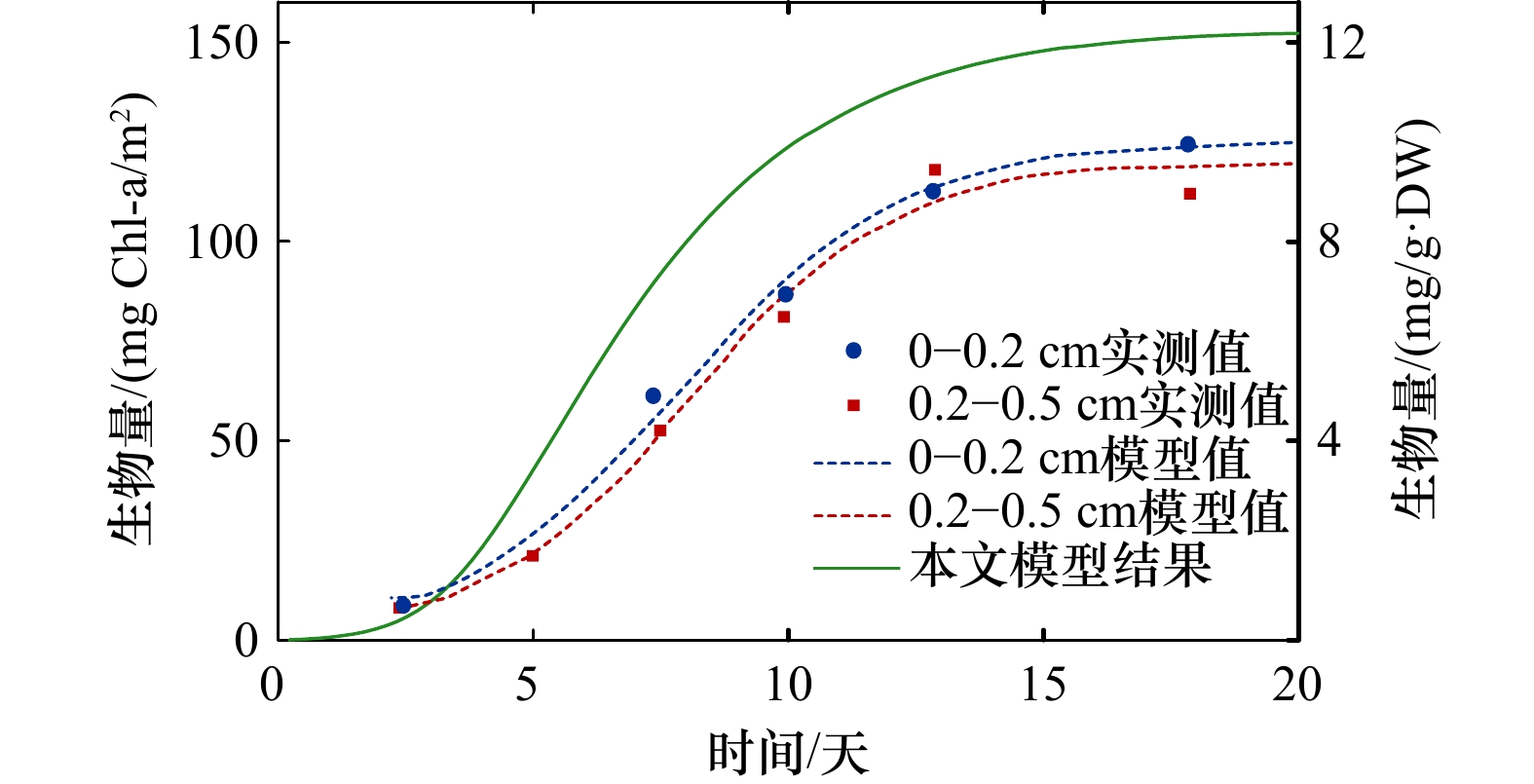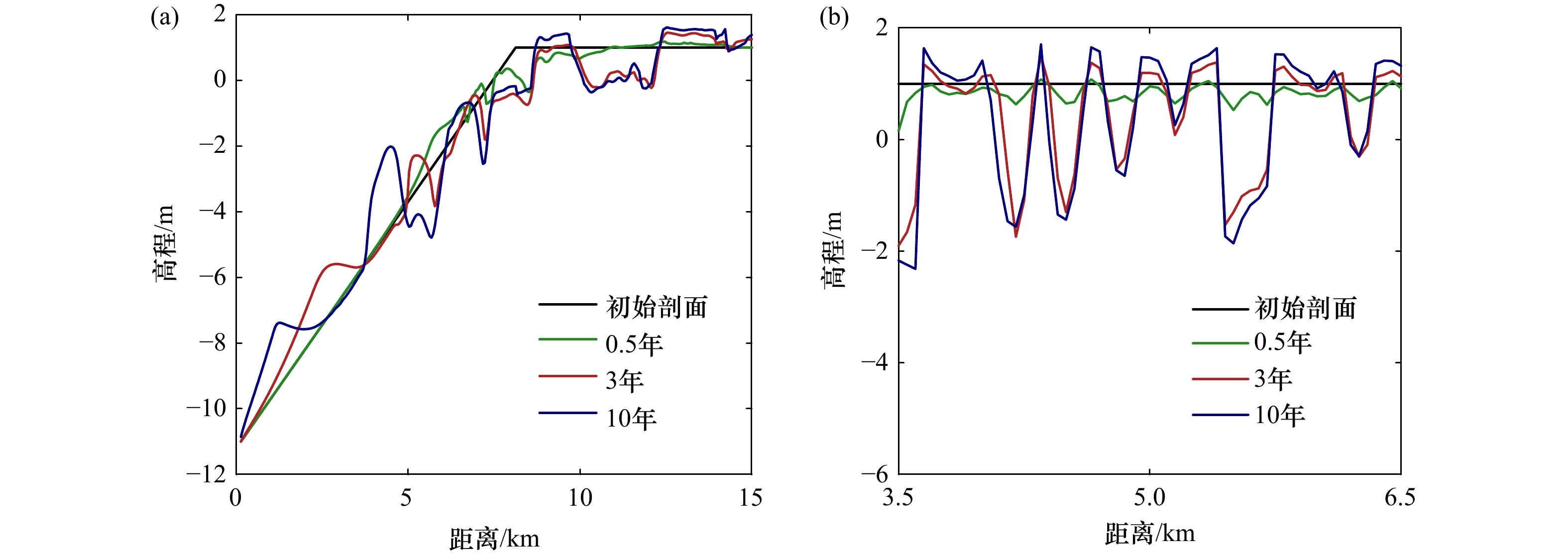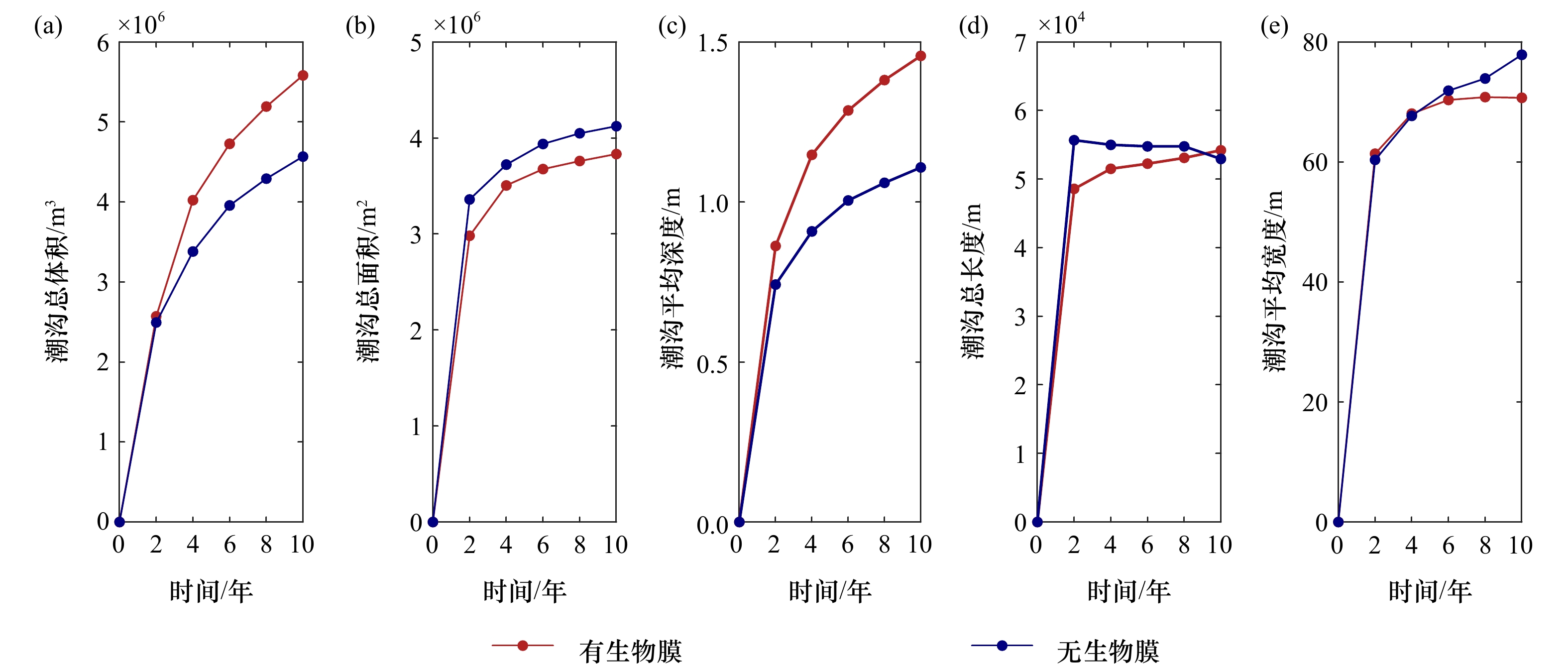Numerical simulation of the influence of biofilm on the dynamic geomorphological evolution of tidal flats
-
摘要: 河口海岸潮滩湿地是一个复杂的生态系统,其地貌的形成和演变是水动力、泥沙输移和生物过程等多种因子相互作用的结果,特别是,探究潮滩生物过程并阐明其生物-物理效应是当前海洋科学领域研究的热点和难点。本文聚焦微生物生物膜,构建了耦合生物膜与水动力、沉积物输移、地貌演变的二维生物动力地貌模型,探究了生物膜在潮滩泥沙输移和地貌演变中发挥的作用。利用文献数据验证生物动力地貌模型,模型结果与文献数据吻合较好,表明所构建的模型可以较好地模拟出生物膜的增长规律及年际变化情况。结果表明,当水动力较弱时,在有生物膜作用的潮滩上,潮沟向陆侧延伸更充分,呈现出树杈状分布,潮间带区域的潮沟两侧分布有生物膜。通过对潮沟形态进行定量分析,发现生物膜的存在促进了潮沟数量增加,并向纵深方向发展,同时限制了其宽度的增加。相较于没有生物膜影响的潮滩,潮沟的平均深度增加,总面积减小,总长度增加,平均宽度减小,总体积增加。研究结果有助于加深对生物膜在潮滩地貌塑造中的作用机制认识,为海岸带保护与生态修复工程提供科学依据。Abstract: Tidal flats maintain a complex ecosystem, while its formation is driven by multi-factor interaction, including hydrodynamics, sediment transport, and biological processes. In particular, investigating tidal flat biological processes and elucidating their biological-physical effects are current research hotspots and challenges in the field of marine science. This study focused on intertidal biofilms, constructed a two-dimensional biomorphodynamic model which coupled biofilms with hydrodynamics, sediment transport, and bed level change, to explore the role of biofilms in sediment transport and geomorphological evolution. The biomorphodynamic model was validated using literature data, indicating that the constructed model can simulate the growth pattern and interannual variation of biofilms well. Model results show that tidal creeks with biofilm attachment are more fully extended towards the landward side, showing a branching distribution when hydrodynamics are weak, and biofilms were distributed on both sides of the intertidal zone. Through quantitative analysis of tidal creek morphology, it is found that the presence of biofilms promoted an increase in the number of tidal creek and their development in the vertical direction, while limiting the increase in their width. Compared to tidal flats without the influence of biofilms, the average depth of tidal creeks increases, the total area decreases, the total length increases, the average width decreases, and the overall volume increases. The research outcome of this study deepens the understanding of the role of biofilms on tidal flat evolution and provides a scientific basis for coastal zone protection and ecological restoration projects.
-
图 9 波流作用下有无生物膜作用时潮沟发育的形态参数统计
a. 潮沟总体积;b. 潮沟总面积;c. 潮沟平均深度;d. 潮沟总长度;e. 潮沟平均宽度
Fig. 9 Statistics of morphological parameters of tidal gully development with or without biofilm under the wave
a. Total volume of channel; b. total area of channel; c. average depth of channel; d. total length of channel; e. average width of channel
表 1 参数设置及取值表
Tab. 1 Parameter setting and value table
变量 单位 取值范围 默认取值 含义 取值依据 μmax day-1 0.007 8~1.11 1.07 参考温度下的最大生长速率 Uehlinger等[34]
Labiod等[35]Ks (mg Chl-a/ m2) -1 0.016 2~0.508 0.02 半饱和常数 Uehlinger等[34]
Labiod等[35]I μE/m2/s – – 每日平均光强 Mariotti等[29] KI μE/m2/s 0.1~50 25 半饱和光系数 Boulêtreau等[36] Io μE/m2/s 0~2 000 300 水面上的每日平均光强 Uehlinger等[34] kd m-1 0.1~3 1.5 光强随水深的衰减系数 Lawson等[37] β °C-1 –0.205~0.022 4 0.01 温度对生物膜发育的影响系数 Uehlinger等[34] To °C – 20 参考温度 Uehlinger等[34] Tmax °C – 33 最高温度 江苏盐城 Tmin °C – –1 最低温度 江苏盐城 ε day-1 ~(0.001~0.1)u* 0.2 整体衰减系数 Uehlinger等[34]
Labiod等[35]Xb mg Chl-a/m2 4.4×10-5~1.68 1 最小生物量 Mariotti等[29] α Pa/(mg Chl-a/m2) 0.001~0.02 0.001 随生物膜生长τcr的增长系数 Le Hir等[33] τcr,o Pa 0.05~1 0.2 无生物膜的泥沙临界起动切应力 Whitehouse等[38] MC – 0~1 0.5 某一泥沙组分下生物量变化的系数 Riethmuller等[32] mct – 0~1 0.5 底床中值粒径小于63μm泥沙的总含量 Riethmuller等[32] Dmin m 0~0.1 0.01 生物膜生存的平均高潮下的最小深度 Mariotti等[39] D m – – 河床高度与高潮位的差 根据模型设置计算取值 表 2 模型参数设置汇总表
Tab. 2 Summary of model parameter settings
参数项 设置值 时间步长 0.3 min 谢才系数 65 m1/2/s 水平涡粘系数 1 m2/s 水平涡粘扩散系数 10 m2/s 潮流边界条件 M2,S2 粉砂 干容重 1 600 kg/m3 中值粒径 50 μm 底床厚度 5 m 粘土 沉速 0.5 mm/s 临界起动切应力 0.2 N/m2 临界沉降切应力 1 000 N/m2 冲刷系数 5×10−4 kg/(m2·s) 底床厚度 10 m 表 3 水动力条件工况设置
Tab. 3 Hydrodynamic condition setting
变量 单位 取值 含义 μmax day−1 0.9 参考温度下的最大生长速率 Ks (mg Chl-a/ m2)−1 0.02 半饱和常数 KI μE/m2/s 25 半饱和光系数 Io μE/m2/s 300 水面上的每日平均光强 kd m−1 1.5 光强随水深的衰减系数 β °C−1 0.022 4 温度对生物膜发育的影响系数 ε day−1 0.2 整体衰减系数 Xb mg Chl-a/m2 1 最小生物量 α Pa/(mg Chl-a/m2) 0.001 6 随生物膜生长τcr的增长系数 To °C 20 参考温度 Tmax °C 33 最高温度 Tmin °C −1 最低温度 表 4 第10年潮沟形态参数
Tab. 4 Morphological parameters of tidal channel in the 10th year
形态参数 无生物膜-潮沟 生物膜-潮沟 同比相差 潮间带下部 潮间带中部 潮滩 潮间带下部 潮间带中部 潮滩 潮间带下部 潮间带中部 潮滩 总体积(106 m3) 0.32 2.66 4.57 0.46 3.50 5.58 45.2% 31.6% 22.1% 总面积(106 m2) 0.27 2.44 4.12 0.32 2.22 3.83 19.8% −9.0% −7.0% 平均深度(m) 1.19 1.09 1.11 1.44 1.57 1.46 21.2% 44.6% 31.5% 总长度(104 m) 0.21 4.13 5.30 0.24 4.18 5.42 13.5% 1.1% 2.3% 平均宽度(m) 127.45 59.20 77.87 134.53 53.26 70.70 5.6% −10.0% −9.2% -
[1] 张长宽, 徐孟飘, 周曾, 等. 潮滩剖面形态与泥沙分选研究进展[J]. 水科学进展, 2018, 29(2): 269−282.Zhang Changkuan, Xu Mengpiao, Zhou Zeng, et al. Advances in cross-shore profile characteristics and sediment sorting dynamics of tidal flats[J]. Advances in Water Science, 2018, 29(2): 269−282. [2] 周曾, 陈雷, 林伟波, 等. 盐沼潮滩生物动力地貌演变研究进展[J]. 水科学进展, 2021, 32(3): 470−484.Zhou Zeng, Chen Lei, Lin Weibo, et al. Advances in biogeomorphology of tidal flat-saltmarsh systems[J]. Advances in Water Science, 2021, 32(3): 470−484. [3] 龚政, 陈欣迪, 周曾, 等. 生物作用对海岸带泥沙运动的影响[J]. 科学通报, 2021, 66(1): 53−62. doi: 10.1360/TB-2020-0291Gong Zheng, Chen Xindi, Zhou Zeng, et al. The roles of biological factors in coastal sediment transport: a review[J]. Chinese Science Bulletin, 2021, 66(1): 53−62. doi: 10.1360/TB-2020-0291 [4] Zhou Zeng, Olabarrieta M, Stefanon L, et al. A comparative study of physical and numerical modeling of tidal network ontogeny[J]. Journal of Geophysical Research: Earth Surface, 2014, 119(4): 892−912. doi: 10.1002/2014JF003092 [5] Xu Fan, Coco G, Zhou Zeng, et al. A numerical study of equilibrium states in tidal network morphodynamics[J]. Ocean Dynamics, 2017, 67(12): 1593−1607. doi: 10.1007/s10236-017-1101-0 [6] Schuerch M, Spencer T, Temmerman S, et al. Future response of global coastal wetlands to sea-level rise[J]. Nature, 2018, 561(7722): 231−234. doi: 10.1038/s41586-018-0476-5 [7] 方红卫, 赵慧明, 何国建, 等. 泥沙颗粒生长生物膜前后表面变化的试验研究[J]. 水利学报, 2011, 42(3): 278−283.Fang Hongwei, Zhao Huiming, He Guojian, et al. Experiment of particles' morphology variation after biofilm growth on sediments[J]. Journal of Hydraulic Engineering, 2011, 42(3): 278−283. [8] Chen Xindi, Zhang C K, Paterson D M, et al. Hindered erosion: the biological mediation of noncohesive sediment behavior[J]. Water Resources Research, 2017, 53(6): 4787−4801. doi: 10.1002/2016WR020105 [9] Andersen T J, Lund-Hansen L C, Pejrup M, et al. Biologically induced differences in erodibility and aggregation of subtidal and intertidal sediments: a possible cause for seasonal changes in sediment deposition[J]. Journal of Marine Systems, 2005, 55(3/4): 123−138. [10] de Deckere E M G T, Tolhurst T J, de Brouwer J F C. Destabilization of cohesive intertidal sediments by infauna[J]. Estuarine, Coastal and Shelf Science, 2001, 53(5): 665−669. doi: 10.1006/ecss.2001.0811 [11] Droppo I G. Biofilm structure and bed stability of five contrasting freshwater sediments[J]. Marine and Freshwater Research, 2009, 60(7): 690−699. doi: 10.1071/MF08019 [12] Gerbersdorf S U, Jancke T, Westrich B, et al. Microbial stabilization of riverine sediments by extracellular polymeric substances[J]. Geobiology, 2008, 6(1): 57−69. doi: 10.1111/j.1472-4669.2007.00120.x [13] Tolhurst T J, Gust G, Paterson D M. The influence of an extracellular polymeric substance (EPS) on cohesive sediment stability[J]. Proceedings in Marine Science, 2002, 5: 409−425. [14] Chen Xindi, Zhang C K, Zhou Z, et al. Stabilizing effects of bacterial biofilms: EPS penetration and redistribution of bed stability down the sediment profile[J]. Journal of Geophysical Research: Biogeosciences, 2017, 122(12): 3113−3125. doi: 10.1002/2017JG004050 [15] Young I R, Verhagen L A. The growth of fetch limited waves in water of finite depth. Part 1. Total energy and peak frequency[J]. Coastal Engineering, 1996, 29(1/2): 47−78. [16] Young I R, Verhagen L A. The growth of fetch limited waves in water of finite depth. Part 2. Spectral evolution[J]. Coastal Engineering, 1996, 29(1/2): 79−99. [17] Tao Jianfeng, Wang Zhengbing, Zhou Zeng, et al. A morphodynamic modeling study on the formation of the large‐scale radial sand ridges in the Southern Yellow Sea[J]. Journal of Geophysical Research: Earth Surface, 2019, 124(7): 1742−1761. doi: 10.1029/2018JF004866 [18] Roberts W, Le Hir P, Whitehouse R J S. Investigation using simple mathematical models of the effect of tidal currents and waves on the profile shape of intertidal mudflats[J]. Continental Shelf Research, 2000, 20(10/11): 1079−1097. [19] Green M O, Coco G. Review of wave-driven sediment resuspension and transport in estuaries[J]. Reviews of Geophysics, 2014, 52(1): 77−117. doi: 10.1002/2013RG000437 [20] Soulsby R L. Dynamics of marine sands: a manual for practical applications[J]. Oceanographic Literature Review, 1997, 44(9): 947. [21] Partheniades E. Erosion and deposition of cohesive soils[J]. Journal of the Hydraulics Division, 1965, 91(1): 105−139. doi: 10.1061/JYCEAJ.0001165 [22] Winterwerp J C. On the sedimentation rate of cohesive sediment[J]. Proceedings in Marine Science, 2007, 8: 209−226. [23] Engelund F, Hansen E. A monograph on sediment transport in alluvial streams[R]. Denmark: Tekniskforlag Skelbrekgade 4 Copenhagen V, 1967. [24] Bagnold R A. An approach to the sediment transport problem from general physics[R]. USGS Numbered Series, 1966. (查阅网上资料, 未找到对应的出版地信息, 请确认) Bagnold R A. An approach to the sediment transport problem from general physics[R]. USGS Numbered Series, 1966. (查阅网上资料, 未找到对应的出版地信息, 请确认) [25] van Rijn L C. Principles of Sediment Transport in Rivers, Estuaries and Coastal Seas[M]. Amsterdam: Aqua Publications, 1993: I11. [26] Roelvink J A. Coastal morphodynamic evolution techniques[J]. Coastal Engineering, 2006, 53(2/3): 277−287. [27] 徐孟飘, 东培华, 马骏, 等. 大小潮作用对潮滩沉积物层理影响的数值模拟研究[J]. 海洋学报, 2021, 43(10): 70−80.Xu Mengpiao, Dong Peihua, Ma Jun, et al. The effects of spring-neap tide on sediment bedding on tidal flats: a numerical study[J]. Haiyang Xuebao, 2021, 43(10): 70−80. [28] van der Wal D, Wielemaker-van den Dool A, Herman P M J. Spatial synchrony in intertidal benthic algal biomass in temperate coastal and estuarine ecosystems[J]. Ecosystems, 2010, 13(2): 338−351. doi: 10.1007/s10021-010-9322-9 [29] Mariotti G, Fagherazzi S. Modeling the effect of tides and waves on benthic biofilms[J]. Journal of Geophysical Research: Biogeosciences, 2012, 117(G4): G04010. [30] Nguyen H M, Bryan K R, Pilditch C A, et al. Influence of ambient temperature on erosion properties of exposed cohesive sediment from an intertidal mudflat[J]. Geo-Marine Letters, 2019, 39(4): 337−347. doi: 10.1007/s00367-019-00579-x [31] Fagherazzi S, Fitzgerald D M, Fulweiler R W, et al. Ecogeomorphology of tidal flats[J]. Treatise on Geomorphology, 2013, 12: 201−220. [32] Riethmüller R, Heineke M, Kühl H, et al. Chlorophyll a concentration as an index of sediment surface stabilisation by microphytobenthos?[J]. Continental Shelf Research, 2000, 20(10/11): 1351−1372. [33] Le Hir P, Monbet Y, Orvain F. Sediment erodability in sediment transport modelling: can we account for biota effects?[J]. Continental Shelf Research, 2007, 27(8): 1116−1142. doi: 10.1016/j.csr.2005.11.016 [34] Uehlinger U, Bührer H, Reichert P. Periphyton dynamics in a floodprone prealpine river: evaluation of significant processes by modelling[J]. Freshwater Biology, 1996, 36(2): 249−263. doi: 10.1046/j.1365-2427.1996.00082.x [35] Labiod C, Godillot R, Caussade B. The relationship between stream periphyton dynamics and near-bed turbulence in rough open-channel flow[J]. Ecological Modelling, 2007, 209(2/4): 78−96. [36] Boulêtreau S, Izagirre O, Garabétian F, et al. Identification of a minimal adequate model to describe the biomass dynamics of river epilithon[J]. River Research and Applications, 2008, 24(1): 36−53. doi: 10.1002/rra.1046 [37] Lawson S E, Wiberg P L, McGlathery K J, et al. Wind-driven sediment suspension controls light availability in a shallow coastal lagoon[J]. Estuaries and Coasts, 2007, 30(1): 102−112. doi: 10.1007/BF02782971 [38] Whitehouse R, Soulsby R, Roberts W, et al. Dynamics of Estuarine Muds: A Manual for Practical Applications[M]. London: T. Telford, 2000. [39] Mariotti G, Fagherazzi S. A numerical model for the coupled long-term evolution of salt marshes and tidal flats[J]. Journal of Geophysical Research:Earth Surface, 2010, 115(F1): F01004. [40] Zhu Q, van Prooijen B C, Maan D C, et al. The heterogeneity of mudflat erodibility[J]. Geomorphology, 2019, 345: 106834. doi: 10.1016/j.geomorph.2019.106834 [41] Guarini J M, Blanchard G F, Bacher C, et al. Dynamics of spatial patterns of microphytobenthic biomass: Inferences from a geostatistical analysis of two comprehensive surveys in Marennes-Oléron Bay (France)[J]. Marine Ecology Progress Series, 1998, 166: 131−141. doi: 10.3354/meps166131 [42] Andersen T J. Seasonal variation in erodibility of two temperate, microtidal mudflats[J]. Estuarine, Coastal and Shelf Science, 2001, 53(1): 1−12. doi: 10.1006/ecss.2001.0790 [43] Chen Xindi, Zhang Changkuan, Paterson D M, et al. The effect of cyclic variation of shear stress on non-cohesive sediment stabilization by microbial biofilms: the role of 'biofilm precursors'[J]. Earth Surface Processes and Landforms, 2019, 44(7): 1471−1481. doi: 10.1002/esp.4573 [44] Fan Daidu. Open-coast tidal flats[M]//Davis Jr R A, Dalrymple R W. Principles of Tidal Sedimentology. Dordrecht: Springer, 2012: 187-229. [45] Zhou Zeng, Ye Qinghua, Coco G. A one-dimensional biomorphodynamic model of tidal flats: sediment sorting, marsh distribution, and carbon accumulation under sea level rise[J]. Advances in Water Resources, 2016, 93: 288−302. doi: 10.1016/j.advwatres.2015.10.011 [46] Zhou Zeng, Liang Mengjiao, Chen Lei, et al. Processes, feedbacks, and morphodynamic evolution of tidal flat–marsh systems: progress and challenges[J]. Water Science and Engineering, 2022, 15(2): 89−102. doi: 10.1016/j.wse.2021.07.002 [47] Blanchard G F, Guarini J M, Gros P, et al. Seasonal effect on the relationship between the photosynthetic capacity of intertidal microphytobenthos and temperature[J]. Journal of Phycology, 1997, 33(5): 723−728. doi: 10.1111/j.0022-3646.1997.00723.x [48] Macintyre H L, Geider R J, Miller D C. Microphytobenthos: the ecological role of the "secret garden" of unvegetated, shallow-water marine habitats. I. Distribution, abundance and primary production[J]. Estuaries, 1996, 19(2): 186−201. doi: 10.2307/1352224 [49] Gerbersdorf S U, Wieprecht S. Biostabilization of cohesive sediments: revisiting the role of abiotic conditions, physiology and diversity of microbes, polymeric secretion, and biofilm architecture[J]. Geobiology, 2015, 13(1): 68−97. doi: 10.1111/gbi.12115 [50] Widdows J, Blauw A, Heip C H R, et al. Role of physical and biological processes in sediment dynamics of a tidal flat in Westerschelde Estuary, SW Netherlands[J]. Marine Ecology Progress Series, 2004, 274: 41−56. doi: 10.3354/meps274041 -





 下载:
下载:









